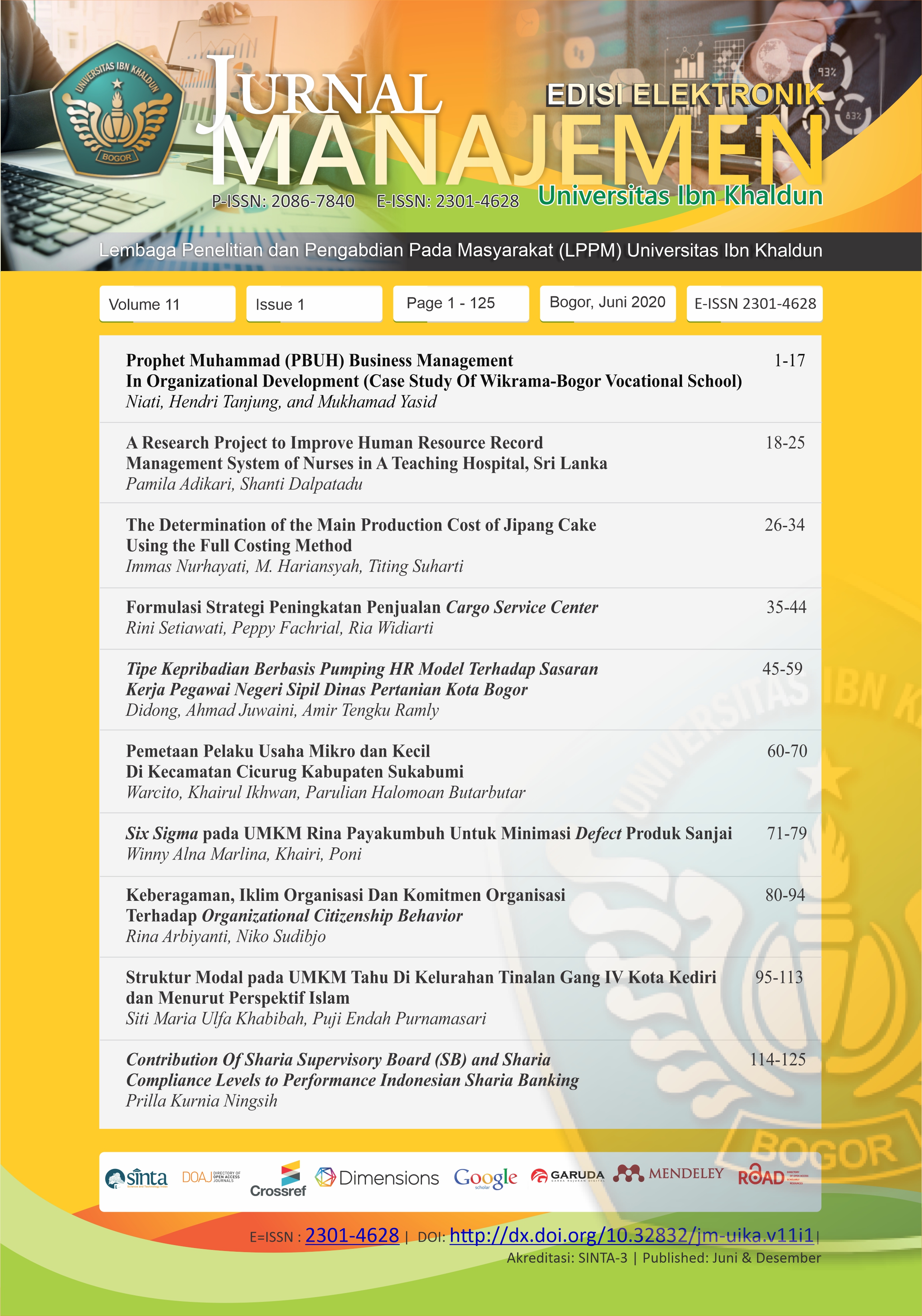The Determination of the Main Production Cost of Jipang Cake Using the Full Costing Method
DOI:
https://doi.org/10.32832/jm-uika.v11i1.2607Keywords:
Jipang, The main of Production Cost, Full Costing Method, Fixed Cost, Variable CostAbstract
The purpose of this study is to determine the main of production cost using the full costing method. The full costing method is one of the methods used in determining the cost of production by taking into account all components of production costs, both fixed and variable costs so that the calculation results are more precise and detailed. This research was conducted in a group of Jipang cake craftsmen in Antajaya Village, Tanjung Sari District, Bogor Regency. The data processed in this study are primary data obtained from the source directly based on real data recorded during the practice or simulation of making Jipang cake at the research location and community service. Based on the calculation, the results of the production cost of Jipang cake based on the full costing method is Rp. 472.15 or rounded to Rp. 500 per pcs.
References
Beutari, D. R., & Laelisneni. (2017). Analisis penetapan harga jual dalam perencanaan laba pada home industri tempe setia budi medan. Jurnal Bisnis Administrasi, 06(01), 52–60. Retrieved from file:///C:/Users/Immas Nurhayati/Downloads/99-213-1-SM (1).pdf
Hansen, D. R. dan M. M. M. (2013). Akuntansi Manajerial. Jakarta: Salemba Empat.
Jasinski, D., Meredith, J., & Kirwan, K. (2015). A comprehensive review of full cost accounting methods and their applicability to the automotive industry. Journal of Cleaner Production, 108, 1123–1139. https://doi.org/10.1016/j.jclepro.2015.06.040
Kotler, P., & Keller, lane. (2012). Marketing Management. Jakarta: Penerbit Erlangga.
Mevita, A. S. (2013). Pengaruh Bauran Pemasaran terhadap Kepuasan Konsmen. Ilmu Dan Riset Manajemen, 2(9), 1–18. Retrieved from http://ejournal.adbisnis.fisip-unmul.ac.id/site/wp-content/uploads/2017/10/JURNAL RIZKA (10-24-17-08-03-59).pdf
Mulyadi. (2010). Akuntansi Biaya. Yogyakarta: Unit penerbit dan percetakan Sekolah Tinggi Ilmu Manajemen YKPN.
Nurhayati, I., Hariansyah, M., & Suharti, T. (2019). Strategi Pengembangan Dan Inovasi Kue Tradisional Jipang Melalui Pembuatan Mesin Pond Hidrolik. (2004), 1268–1275.
Pelealu, A. J. H., Manoppo, W. S., & Mangindaan, J. V. (2018). Analisis Perhitungan Harga Pokok Produksi Dengan Menggunakan Metode Full Costing Sebagai Dasar Perhitungan Harga Jual (Studi Kasus Pada Kertina's Home Industry). Jurnal Administrasi Bisnis, 6(2), 34–40. Retrieved from https://media.neliti.com/media/publications/269396-analisis-perhitungan-harga-pokok-produks-03dec2a3.pdf
Sempati. (2017). Persepsi dan perilaku remaja terhadap makanan tradisional dan makanan modern skripsi. 1–83. Retrieved from http://journal.student.uny.ac.id/ojs/index.php/boga/article/viewFile/8291/7886
Supriyono. (1999). Akuntansi Biaya: Pengumpulan Biaya dan Penentuan Harga Pokok (2nd ed.). Yogyakarta: BPFE.
Susilawati, N. E., Setiono, H., Si, M., & Dwihandoko, T. H. (2019). Perhitungan Harga Pokok Produksi dengan Metode Full Costing dan Variabel Costing pada Home Industri Aneka Camilan Khas Pacet "Sumber Rizki.” Repositori Universitas Islam Majapahit. Retrieved from. http://repository.unim.ac.id/id/eprint/356
Downloads
Published
How to Cite
Issue
Section
License
Authors who publish with this journal agree to the following terms:
- Authors retain copyright and grant the journal right of first publication with the work simultaneously licensed under a Creative Commons Attribution-NonCommercial-ShareAlike 4.0 International License that allows others to share the work with an acknowledgement of the work's authorship and initial publication in this journal.
- Authors can enter into separate, additional contractual arrangements for the non-exclusive distribution of the journal's published version of the work (e.g., post it to an institutional repository or publish it in a book), with an acknowledgement of its initial publication in this journal.
- Authors are permitted and encouraged to post their work online (e.g., in institutional repositories or on their website) prior to and during the submission process, as it can lead to productive exchanges, as well as earlier and greater citation of published work (See The Effect of Open Access).











